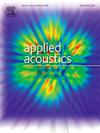Measurement uncertainty of ISO CD 23351-2: acoustic performance of furniture ensembles and enclosures in situ
IF 3.4
2区 物理与天体物理
Q1 ACOUSTICS
引用次数: 0
Abstract
Enclosures (E), such as mobile pods or rooms, and partial enclosures (PE), such as sofa groups and open pods, are increasingly used in indoor environments where occupants temporarily need better speech privacy or peace of work. Such objects are usually tested in laboratory using ISO 23351-1. That standard excludes very large objects. In addition, acousticians need to measure objects in situ. The field method, ISO CD 23351-2 is based on sound power level tests according to ISO 3744 standard. The main outcome is apparent speech level difference, D’S,A [dB]. Since the method of ISO CD 23351-2 is novel, information about measurement uncertainty (MU) is lacking. Our purpose was to determine the uncertainty by conducting two independent studies: 1. between-laboratory study and 2. between-room study. In study 1, thirteen participants tested one PE and one E in the same room. Based on eight accepted participants, the between-laboratory standard deviations (SD) of D’S,A were 0.8 dB for PE and 0.7 dB for E. In study 2, a single participant tested one PE and one E in ten different rooms. The between-room SDs of D’S,A were 0.6 dB both for PE and E. The total SD was 1.0 dB and it considers the MUs both due to operator and room choice. The results can be useful in the finishing of ISO 23351-2 standard. Our study also provides data regarding the MU of ISO 3744 and ISO 3382-2 standards.
ISO CD 23351-2的测量不确定度:现场家具组合和外壳的声学性能
围护结构(E),如移动吊舱或房间,以及部分围护结构(PE),如沙发组和开放式吊舱,越来越多地用于居住者暂时需要更好的语音隐私或工作宁静的室内环境。这些物品通常在实验室使用ISO 23351-1进行测试。这个标准排除了非常大的物体。此外,声学家需要在现场测量物体。现场方法,ISO CD 23351-2是根据ISO 3744标准进行声功率级测试。主要结果为表观言语水平差异,D 'S,A [dB]。由于ISO CD 23351-2方法新颖,缺乏测量不确定度(MU)的信息。我们的目的是通过进行两项独立研究来确定不确定性:1。介于实验室研究和2之间。between-room研究。在研究1中,13名参与者在同一个房间里测试一个PE和一个E。在8名被接受的参与者中,PE和E的实验室间标准差(SD)分别为0.8 dB和0.7 dB。在研究2中,单个参与者在10个不同的房间测试了一个PE和一个E。PE和e的房间间标准差为0.6 dB,总标准差为1.0 dB,它考虑了操作员和房间选择的最小值。所得结果可为ISO 23351-2标准的整理提供参考。我们的研究还提供了有关ISO 3744和ISO 3382-2标准的MU的数据。
本文章由计算机程序翻译,如有差异,请以英文原文为准。
求助全文
约1分钟内获得全文
求助全文
来源期刊

Applied Acoustics
物理-声学
CiteScore
7.40
自引率
11.80%
发文量
618
审稿时长
7.5 months
期刊介绍:
Since its launch in 1968, Applied Acoustics has been publishing high quality research papers providing state-of-the-art coverage of research findings for engineers and scientists involved in applications of acoustics in the widest sense.
Applied Acoustics looks not only at recent developments in the understanding of acoustics but also at ways of exploiting that understanding. The Journal aims to encourage the exchange of practical experience through publication and in so doing creates a fund of technological information that can be used for solving related problems. The presentation of information in graphical or tabular form is especially encouraged. If a report of a mathematical development is a necessary part of a paper it is important to ensure that it is there only as an integral part of a practical solution to a problem and is supported by data. Applied Acoustics encourages the exchange of practical experience in the following ways: • Complete Papers • Short Technical Notes • Review Articles; and thereby provides a wealth of technological information that can be used to solve related problems.
Manuscripts that address all fields of applications of acoustics ranging from medicine and NDT to the environment and buildings are welcome.
 求助内容:
求助内容: 应助结果提醒方式:
应助结果提醒方式:


